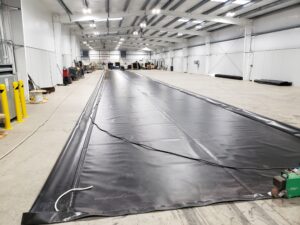For the past five decades, geomembranes have served as a cornerstone material in civil engineering projects where liquid or gas containment is critical. These impermeable liners are essential for protecting soil and groundwater from contamination in applications such as agricultural reservoirs, industrial effluent systems, and hydrocarbon containment.
Given the sensitivity of these applications, even a minor error in either fabrication or installation can result in costly failures. Understanding the strengths and limitations of the different geomembrane installation methods is key to making the best decision for your project.
Table of Contents
- Speak with a Geomembrane Specialist
- Understanding the Importance of Seam Integrity
- Factory vs. Field Fabrication: A Technical Comparison
- Field-Fabricated Liners
- Factory-Fabricated Panels
- Better Results, Lower Costs
- Why Factory Fabrication Is the Smarter Choice
Speak with a Geomembrane Specialist
Understanding the Importance of Seam Integrity
Seams, where two geomembrane sheets meet, are the most vulnerable points in any liner system. If these joints are poorly executed, they can become sources of leaks and system failure.
The strength of these welds, both in terms of shear and peel resistance, is critical. That’s why rigorous testing of seam performance is required throughout the installation process. For factory-welded seams, this testing is streamlined and more consistent than in field environments, where conditions can vary drastically.
Factory vs. Field Fabrication: A Technical Comparison
While installing geomembranes might appear straightforward, the choice between factory and field fabrication can have major implications for performance, cost, and schedule. Here’s how the two approaches compare:
Field-Fabricated Liners
This traditional method involves welding geomembrane panels directly at the project site. For HDPE membranes, field fabrication is often the standard due to the material’s rigidity.
However, field conditions are rarely ideal. Challenges such as uneven terrain, contamination from dust or debris, temperature swings, and UV exposure can compromise the quality of field seams. Additionally, this method demands a larger labor force and frequent destructive testing to verify seam quality.
Due to these complexities, field fabrication often carries higher labor costs and a greater risk of errors; particularly for geomembranes that are more flexible and sensitive than HDPE.
Factory-Fabricated Panels
Factory fabrication involves welding geomembrane panels in a clean, controlled environment. These large panels are then folded or rolled and shipped to the job site, where only the perimeter welds need to be completed and tested.
Seams produced in a factory are consistently high-quality thanks to uniform conditions and the ability to immediately test and fine-tune the process. Unlike in the field, adjustments can be made without delay or disruption.
This approach significantly reduces onsite labor and shortens installation timelines, advantages that are especially valuable on large-scale projects or where weather-related delays are a concern.
Better Results, Lower Costs
By shifting the bulk of fabrication to a controlled facility, projects benefit from reduced installation times and improved seam reliability. Fewer workers are required on site, and equipment needs are minimized. These advantages often translate to meaningful cost savings, particularly for installations on a tight timeline.
In the end, factory-fabricated liners provide a higher-quality product with fewer opportunities for error, making them a cost-effective alternative to field fabrication.
Why Factory Fabrication Is the Smarter Choice
Pre-fabricated geomembrane panels are becoming the go-to solution for contractors and engineers looking to streamline their projects without compromising quality. This method is particularly well-suited to fast-paced jobs or locations where weather can pose logistical challenges.
While field welding still has a place (particularly for materials like HDPE) most flexible geomembranes perform better when factory-fabricated. With a reduced risk of defects, faster installs, and fewer personnel required, factory fabrication often delivers a better return on investment.
A Message from Jimmie Eloff, President of GLL
“At GLL, we specialize in providing comprehensive geosynthetic solutions. Factory-fabricated geomembranes allow us to deliver pre-assembled panels that meet strict quality standards and reduce installation times significantly.
Whether we’re supplying raw rolls or custom panels, our focus is on helping clients make informed decisions. This article outlines the factors we walk through with our partners to determine the most effective installation method. The result is faster deployment, greater efficiency, and lower total costs.”
– Jimmie Eloff, President, GLL


